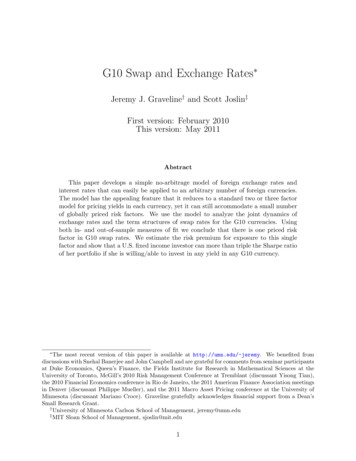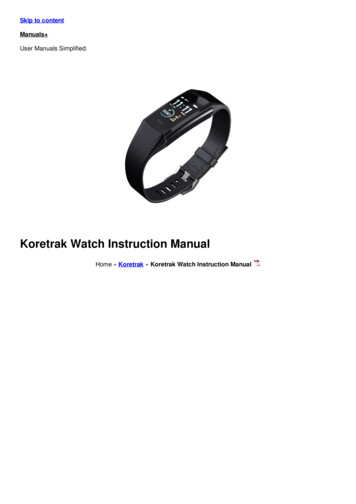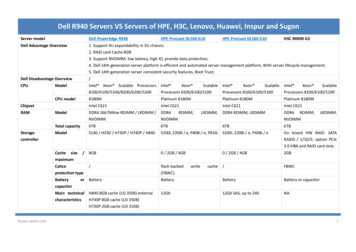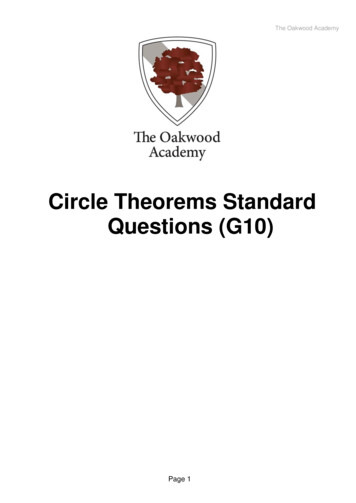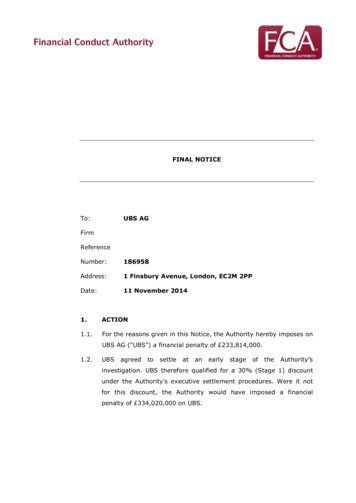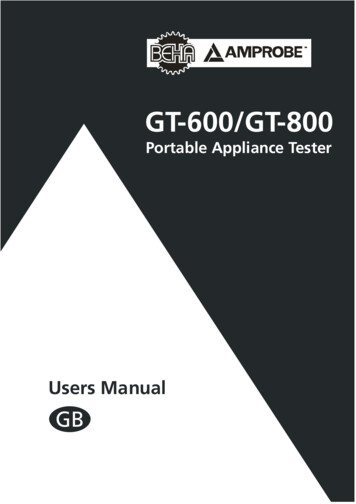
Transcription
BAE AUDIOG10 INSTRUCTION MANUAL
BAE AUDIO – G10G10 Graphic EqualiserCongratulations! You’ve purchased a G10 500 Series 10-Band equalizer. This EQ has balanced input andoutput and hi/low-pass filters and is the ultimate hands-on sound shaping tool for tracking, mixing, or mastering.About the G10:The G10 combines a punchy, transformer-based signal path with the versatile 10-band graphic EQ configurationand a 2520 style op-amp — making it ideal for tweaking drum or guitar sounds, or even processing an entire mix.With 10 carefully selected bands offering up to 12 dB of boost or cut on tap, the G10 offers a level of tonesculpting that can help any audio sit perfectly in the mix. The easy-to-use slider-based interface helps usersintuitively visualize the EQ curves they are applying. Switchable high-pass and low-pass filters, tuned at 80 Hzand 12 kHz respectively, help make the G10 a truly complete sound shaping solution.The BAE Audio G10 implements an op-amp like those used in well-loved ‘70s American boards. Unlike someother 10-band equalizers presently on the market, the G10 is fully transformer balanced on the input and output.The G10 also features a CineMag transformer balanced in and out that imbues any audio passing through it witha unique tonal character.Installation of 500 Series Units:Follow the instructions provided by the manufacturer of your 500 series rack and power supply to install yourG10. Make sure that the card is firmly seated in the slot and fully screw the installation screws into the 500 seriesrack enclosure. Your input and output connections will be provided on the rear of the rack enclosure either asXLR connectors or part of a DSUB 25 array.EQ Sliders:Each of these sliders will give 12 dB of “Boost” and 12 dB of “Cut”. There are ten sliders per channel – ten forthe Left channel, and ten for the Right channel. Looking at the front panel, the sliders that control the lowestfrequencies are on the left, with the higher frequencies farther right. Usually, identical adjustments should bemade for both channels These sliders are one octave apart from one another. This corresponds with the entirerange of human hearing. The last page of this owners’ manual contains a chart, showing which sliders to adjustto affect the sound of various instruments. For instance, the lowest note of a bass guitar is 42 Hz. By adjustingthe sliders at 30 Hz and 60 Hz you can raise or lower the volume of the bass guitar, bass drum, and any othermusical instruments that occupy this frequency range. On the other hand, the sound of the female vocalistoccupies a frequency range from roughly 200 Hz to 1500 Hz. By adjusting the sliders within this range, you canchange the tonal character of the female voice, and any other musical instruments that occupy this frequencyrange.BAE G10 20171
BAE AUDIO – G10Fully Transformer BalancedThe BAE Audio G10 implements an op-amp like those used in well-loved ‘70s American boards. Unlike someother 10-band equalizers presently on the market, the G10 is fully transformer balanced on the input and output.The G10 also features a CineMag transformer balanced in and out that imbues any audio passing through it witha unique tonal character.EQ FrequenciesSub bass – 20Hz-60HzWhile humans can technically hear down to this region, it’s less cerebral and more gut. Somewhere down hereis where your subwoofer will make that eerie sound of deep space in sci-fi movies, and this region can add someserious, unearthly power. However, you would very rarely want to add more of this sound, and taking away fromhere can help give the music more overall clarity.Bass – 60-200HzThe majority of the time, a stalwart hip-hop groove will start at or around 60Hz. The foundational, big-hitting lowerregister rests in this domain, including the heavy punch of the kick drum, and even lower tom drums and bassguitar. Moving up towards the 200Hz line begins to affect the very lowest boom of acoustic guitars, piano, lowerbrass and strings. If the music is too darned heavy, or not heavy enough down low, a bit of an adjustment herewill help.Upper bass to lower midrange – 200Hz-800HzRising above 200Hz starts to deal with the lighter side of the low end. This region is where the meatier body ofan instrument hangs out. Adding EQ around the middle of this spectrum can add a bit of oomph to richer tones,including the lower end of vocals, deeper notes from synthesizers, low brass and piano, and some of the goldentones from the bottom of an acoustic guitar. Lowering the level a bit here can clear up some space, and open upthe sound. Moving to the 800Hz region, you’ll start to affect the body of instruments, lending more weight withaddition, or lightening the load with subtraction.Midrange – 800Hz-2kHzThis area is a touchy one, and can change the sound quickly. Putting on the brakes in this region can take awaythe brittle sound of instruments. Adding some juice can give things a metallic touch, and can wear down your earquickly if pushed.2BAE G10 2017
BAE AUDIO – G10EQ Frequencies (Continued)Upper mids – 2kHz-4kHzAs mentioned above, this register is where your ears aim a lot of their focus. Adding or subtracting here can raiseor lower the snap of higher instrumentation quickly. Sounds like the pop of snare, and the brash blare of trumpetcan all be affected here. Adding a little push here can give more clarity to vocal consonances, as well as acousticand electric guitar, and piano.Presence/sibilance register – 4kHz-7kHzThis is commonly referred to as the presence zone, and leads into the highest range of pitches produced by mostnatural instruments. Boosting the lower end of this scale can make the music sound more forward, as if pusheda little closer to your ears. Backing it off can open the sound, and push instruments away for more depth. The topend of this region is also responsible for the sharp hissing “s” of vocals, known as sibilance. If sharp consonantsare popping out at you like the bite of a snake, cutting a few dB from around 5-7kHz can solve the issue, andsave you some pain and suffering.Brilliance/sparkle register 7Hz-12kHzRaising or decreasing the level at the lower end of this register can help bring some vibrance and clarity, addinga tighter attack and a more pure sound. If things are a little too sharp, or causing some pain after listening fortoo long, lowering the bottom end of this register can help out quite a bit. Towards the top is where things startto space out into less tangible definition, moving away from what you can hear more towards what you can feel.That shimmering resonance at the tip of a cymbal crash floats around in the regions of this space.Open air – 12kHz -16kHzOnce you get up here, things really become more subjective. The bottom registers continue to affect the higherovertones of instrumentation, and synth effects from electronic music can pop around in that region as well.Moving further up, it becomes more about creating a spacier, open sound. However, there are very few points inwhich you’d want to affect the sound much around 14kHz or above — many older listeners won’t be able to evenhear these sounds. If you want to boost a bit of space in the belfries of the music, you can add some level here.Too much, however, will make things start to sound synthetic.BAE G10 20173
BAE AUDIO – G101073D Specifications & FeaturesNoise:Better than -90dB (EQ IN, 1KHz @ 0dBu,A-weighted)Complies with 500 Series Specification formechanical and electrical interface /- 12dB Boost/Cut @ 31Hz, 63Hz,125Hz,250Hz, 500Hz, 1KHz, 2KHz, 4KHz, 8KHz,16KHzTHD N:0.0036% (EQ IN, 1KHz @ 0dBu, A-weighted)Input Signal Before Clip: 28dBu (1KHz)Individually Selectable LPF @ 12KHz, andHPF @ 80Hz (approx. 6 and 10 dB per octave, respectively)Power Supply: /- 16VDC @ 45mA per RailEQ In/Out Select Switch (bypasses EQ andFilters)Weight1.75 LBSFully enclosed ventilated steel enclosureCineMag transformer balanced in/outDimensions in Inches4.5W x 5.25H x 5.5DTop quality components used throughoutTroubleshootingThere are many 500 series racks available, each with slightly different power supplies. Some older 500 racks arenotorious for power supply problems.500 series power supplies are actually two supplies, a 16 Volt and a -16 Volt source. If you turn on the unit, butget no audio, there is a chance that one of the supplies in the rack has either gone down or is in protection mode.This has the potential to cause damage to your 1073D if left like this for a long time.To verify that a power supply fault has occurred, engage all of the push buttons including the 1/4” input switchwith the blue LED. If the blue LED does NOT light, then there is a problem with your power supply.4BAE G10 2017
BAE AUDIO – G105 YEAR WARRANTYALL BAE pedals have a 5 year warranty on the circuit-electronics and one year on the footswitch.Warranty is only covered on part failure and not customer neglect.BAE audio is not responsible for injuries incurred whilst using our products nor any damage to other items relatedor non related to the use of our product.Disclaimer: All sales are subject to verification. BAE reserves the right to suspend warranty coverage for anyproduct that has been sold under MAP/list Price or purchased from an unauthorized seller.Warranty RegistrationMail:BAE Audio7421 Laurel CanyonUnit 14North Hollywood, CA Serial Number:Invoice Number:Dealer:Price Paid:Name:Address:City:State:Postal Code:Phone Number:Email Address:How did you hear about us?BAE G10 20175
BAE AUDIO – G10RECALL SHEET6BAE G10 2017
www.baeaudio.com
The G10 combines a punchy, transformer-based signal path with the versatile 10-band graphic EQ configuration and a 2520 style op-amp — making it ideal for tweaking drum or guitar sounds, or even processing an entire mix. With 10 carefully selected bands offering up to 12 dB of boost or cut on tap, the G10 offers a level of tone .


